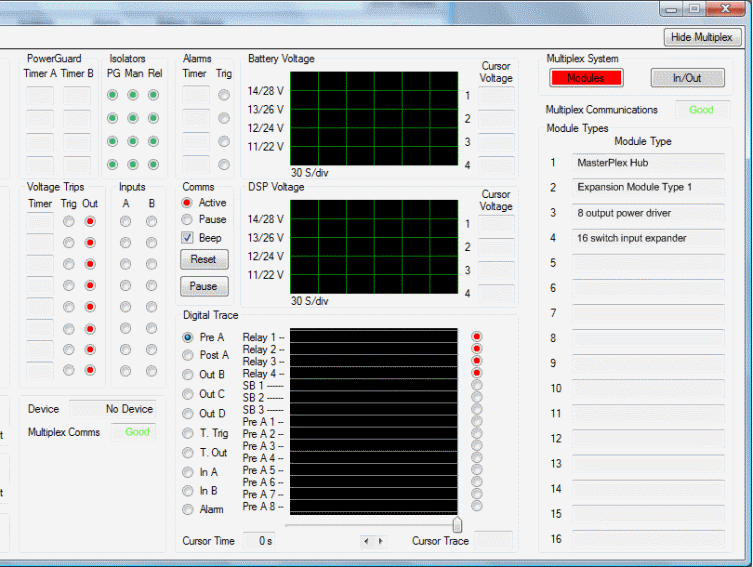
Screen shot of the expanded section of the diagnostics screen. The section on the right shows the multiplex expansion modules (three in this case - up to a maximum of 15 plus the hub itself) which have been automatically detected by the hub. The hub always takes address 1.
It is not necessary to tell the hub what modules are installed. It is not necessary to manually set up an address on each module as it often is with other multiplex systems. The modules are detected automatically and each one is allocated its own unique address. This allows very simple "swap out" of modules. There is no new configuration to be carried out. Simply replace the module and it will be detected by the hub then automatically reprogrammed in the identical configuration as its predecessor.
A common complaint of primitive multiplex systems is what happens to an output module if communications is lost with the hub (say a broken or pulled cable or in military vehicle the hub actually getting shot). With MasterPlex a default output state can be set for each individual output in each individual module. This is carried out in the normal MasterPlex Configuration software. Whilst communications is functional the output module operates as instructed by the hub. In the event of a communications failure the output module will instantly (within 50mS) switch to its default state.
This prevents failed comms from shutting down sections of an installation.
Now here's the really clever part in this.....
One or two people have mentioned that in order for the expansion module to be able to switch to a pre-programmed default state, the expansion module itself has to have this data stored in its own internal memory. This is quite correct. This then leads them to believe that the expansion module has to be programmed by the user. We have also been asked whether this means that swapping an expansion module means reprogramming the hub or whether the module has to be connected to the hub at the time of programming. Neither of these are the case......
The default output state data is set up in the Configuration Software on the PC along with all the other settings. When the hub is programmed this data is then stored in the hub. When the expansion module is connected the hub reprograms the expansion module with the default data. It takes less than 50mS for the expansion module to be automatically reprogrammed by the hub. The expansion module only needs to be connected to the hub for just over 50mS (which does not have to be at the time the hub is programmed) for this entire process to take place.
If a module needs to be replaced, neither the module nor the hub have to be reconfigured. This is done automatically as soon as the new module is plugged in.
This entire process is totally automatic and completely transparent to the user.